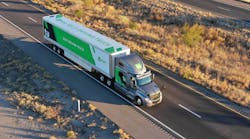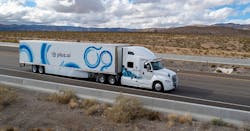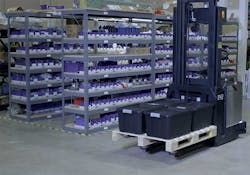If you’ve traveled recently along the flat, tumbleweed-strewn stretch of Interstate-10 between Phoenix and Tucson lately, you may have glimpsed a tractor-trailer or two sporting lime green accents and branded with the company name “TuSimple.” They may look like relatively ordinary long haulers, but the story being told between the highway lines is neither simplistic or ordinary. What you’re witnessing is a new chapter in transportation history being written by incredibly complex self-driving trucks.
By the end of this leg of the journey, the autonomous vehicle startup TuSimple hopes to be the first to reach Stage 4 of autonomous driving (as defined by the Society of Automotive Engineers), which does not require humans to take the wheel under certain conditions.
And it gets closer every day, with teams of a safety operator and test engineer collecting road and environmental data from the cameras, LiDAR, radar and ultrasonic sensors to feed into the machine learning algorithms and checking hardware and software response time. The system doubles the standard 500-meter detection range, the distance generally needed for a Class 8 truck on the highway to safely stop, with a 1,000-meter forward camera.
“[This] extends our range an additional 500 meters which allows our planning system to operate strategically, enabling our self-driving system to engage in and plan for the safest and most efficient behaviors possible,” the company writes in its 2019 self-driving safety report. With this sensor stack, the truck now has a 35-second window to react to whatever variables the road throws at them
Along with fellow self-driving truck startup Plus.ai, the four-year-old TuSimple has recently leveled up to “unicorn” status, surpassing a valuation over $1 billion. Plus.AI is a Cupertino, Calif.-based startup founded by Stanford alumni and has research facilities in Silicon Valley and Beijing.
The TuSimple Autonomous Driving System has been tested between its testing facility in Tucson and Phoenix since Aug. 2017. Since May, the San Diego-based tech company has partnered with UPS to demonstrate its depot-to-depot capabilities along the same route.
TuSimple’s Series D funding recently hit $215 million, with investments from UPS and Mando Corp., a tier-1 supplier. The company now has 500 employees worldwide and $298 million in overall funding.
“With over 50 trucks on the road worldwide and more than 18 contracted customers, we are excited about the momentum the company has achieved in four short years,” said TuSimple CFO Cheng Lu.
TuSimple believes once the technology is proven out and the manufacturing is scaled to fleet-level commercial availability, these autonomous trucks could lower costs, reduce carbon emissions, improve fleet logistics and most importantly, save lives.
Safety First
That last one may seem counterintuitive, as having no one behind the wheel shouldn’t be safer than having an experienced driver. Already in warehouses and factories, managers are finding this to be true, though, as self-driving material handlers are phasing out traditional forklifts. In various manufacturing environments, Pittsburgh-based Seegrid has hit 2 million miles driven without an accident with its vision-guided vehicles. These rely on stereoscopic cameras for better depth perception. Forklift accidents killed 91 U.S. workers in 2016, according to the U.S. Bureau of Labor Statistics.
Fatal accidents involving trucks are on the rise, according to the National Highway Traffic Safety Administration. The agency says large truck-related crashes killed 4,761 people in 2017, up 9% from 2016. About four out of every five of these involved heavy large trucks (GVWR>26,000 lb.).
The number of trucks on the road and miles driven typically increase year-over-year, and 2017 was a very good year economically, with annual GDP growth of 2.2% versus 1.6% the previous year. More trucks moving more freight equals more opportunities for crashes. In 2017, that number of forklift deaths dropped to 74, or almost 19%. There’s not enough data to prove causality, but despite demand growing, factories have reduced fatal accidents while transporting materials while increasing the amount of automated material handling equipment.
These closed, controlled facilities are busy and have more pedestrians sharing the travel space, but do not deal with anywhere near the same speeds or weight that trucks do. And everyone in a factory is at least trained to coexist with forklifts and other mobile heavy equipment.
On the highway, truckers must contend with the weather and even more unpredictable distracted drivers, who at any point may be drunk, texting or perhaps drunk texting. According to The Zebra, drunk driving kills 10,000 people annually and distracted driving takes 3,500 lives.
A 2013 University of Michigan Transportation Research Institute study found that in a sample size of 8,309 fatal accidents involving cars and trucks, the car was at fault 81% of the time. But when you’re in a 70-mph wrecking ball and someone else is in an aluminum can, might make wrong. Having more sensors to better detect bad actors on the road just makes sense. And having a computer analyze and act on that sensor data is even more sensible, even if that incenses current drivers.
The Human Factor
As capable as many veteran drivers are, they are never going to be as efficient as an automated system designed specifically for the task. If That doesn’t mean robots are infallible; it’s just that humans are so incredibly flawed. That’s part of our charm, of course, but if you’re running a fleet, the smart play is to eventually migrate over to a robotic system. You may put many drivers out of work, but you’ll also circumvent the omnipresent driver turnover, which can be 94% at fleets with more than $30 million in annual revenue and 73% at smaller fleets. There’s the increasingly problematic driver shortage as well.
And why would the up-and-coming entrants into the workforce choose a career where they can’t be on their phone at work and has a mortality rate nearly eight times higher than average (26.8 vs. 3.5/10,000)?
But again, this goes back to why would a private fleet with thousands of trucks choose the more unpredictable model. The one that doesn’t get drunk or get addicted to opioids, the one that doesn’t fall asleep after weeks on the road.
One-third of fatal crashes had a driver-related cause, according to the Federal Motor Carrier Safety Administration. Of course, TuSimple makes sure to mention that in its safety report.
But there are so many other reasons, laid out in a comprehensive report by an Arizona law firm, Begam Marks and Traulsen. It makes TuSimple’s case even more clear.
Some of the stats have already been mentioned, but a few more driver-related elements include:
- Failure to yield right of way
- Careless driving
- Overcorrecting
- Erratic or reckless operation
- Improper lane changes and turns
Manufacturers realized several years ago that for repetitious, dangerous jobs, robots are the answer. They process faster, don’t get tired and don’t demand better pay or benefits. So the appeal for fleet owners seems pretty obvious.
But this is only the very beginning. And a straight stretch of desert asphalt with optimal visibility is essentially a safe sandbox for TuSimple’s engineers to perfect their technology. What happens on a snowy curve on the Pennsylvania turnpike or the busy, wet roadways after a Carolina rainstorm has yet to be written. A good guess is that trucking will follow an increasingly popular model in factories, where humans and collaborative robots work together to provide the most optimal result.
That may seem like a costly solution, but when you consider the cost of Walmart’s payoff to actor Tracy Morgan, rumored to be $90 million but probably less, it’s a drop in the bucket. And if your fleet offers a collaborative model with the best of human and robot interaction, you’re giving customers and employees plenty of reasons to stick with you.







